
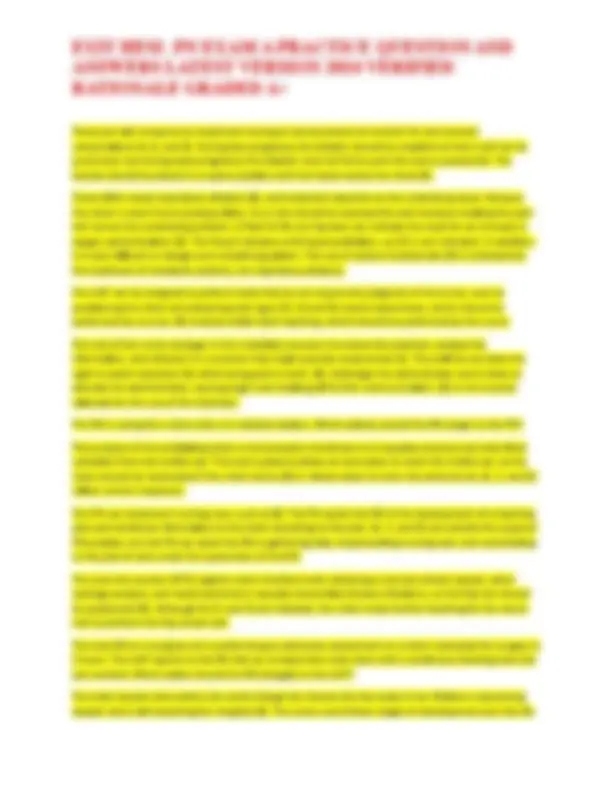
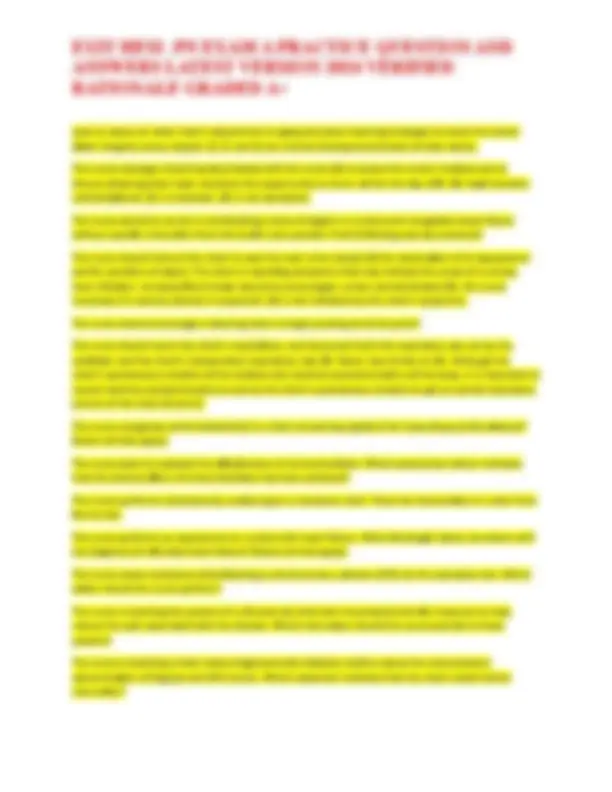
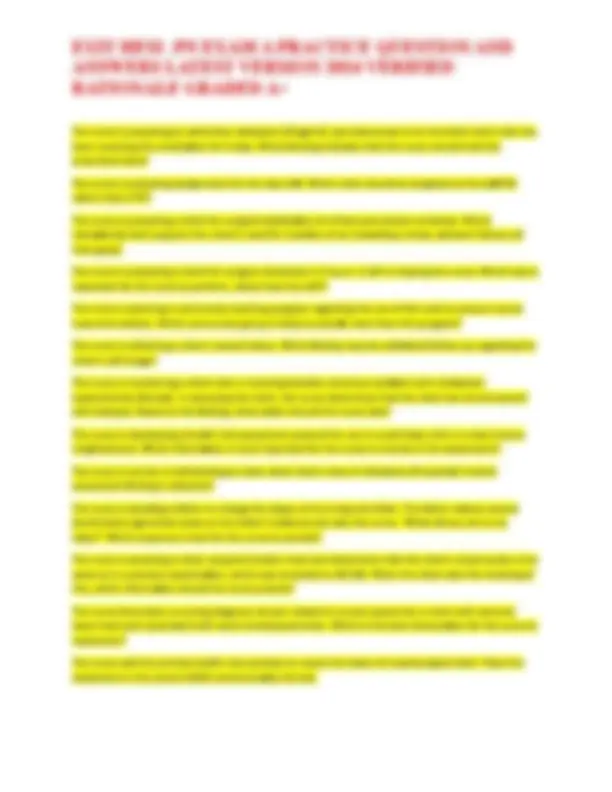
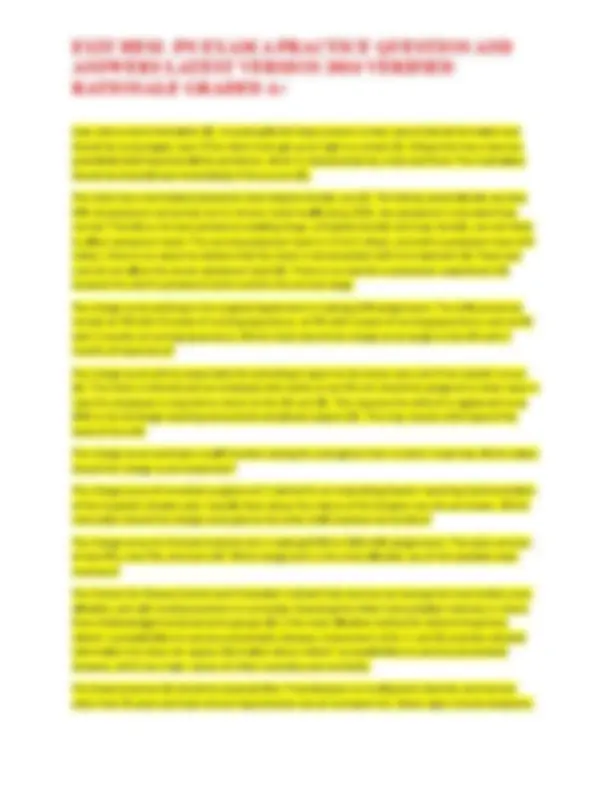
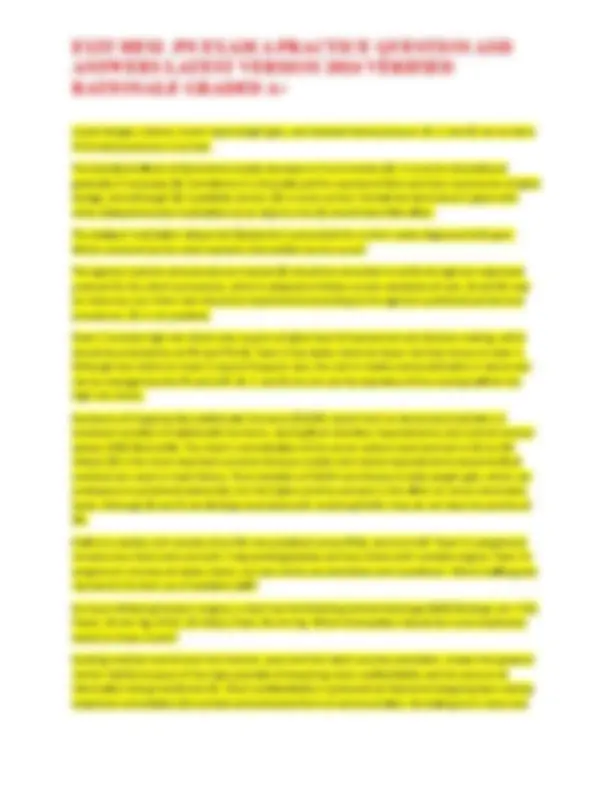
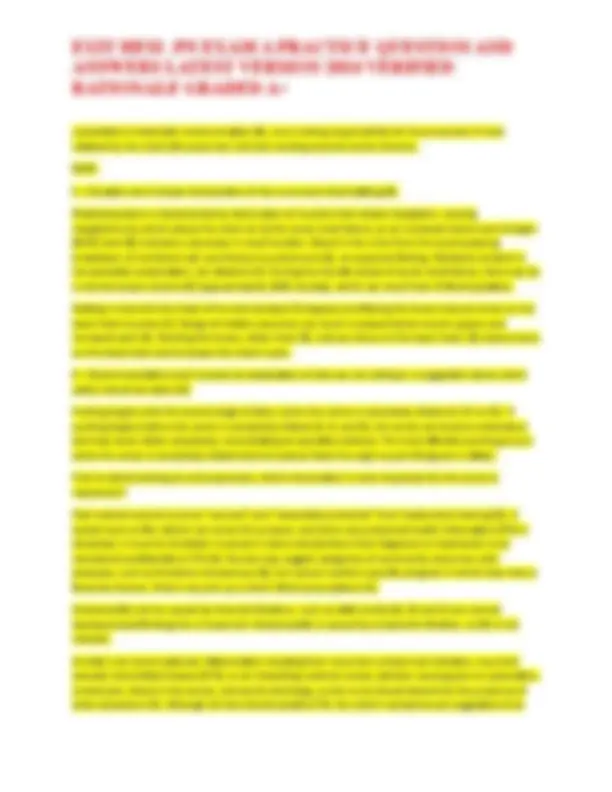
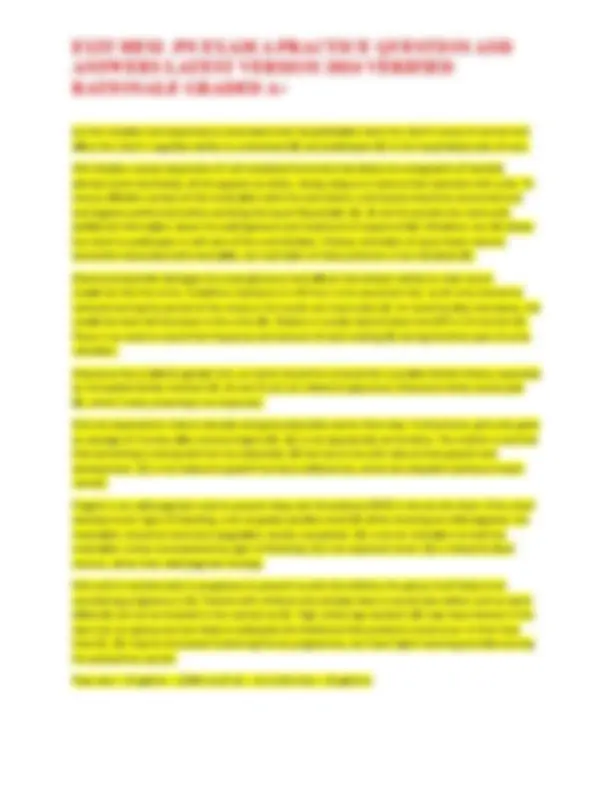
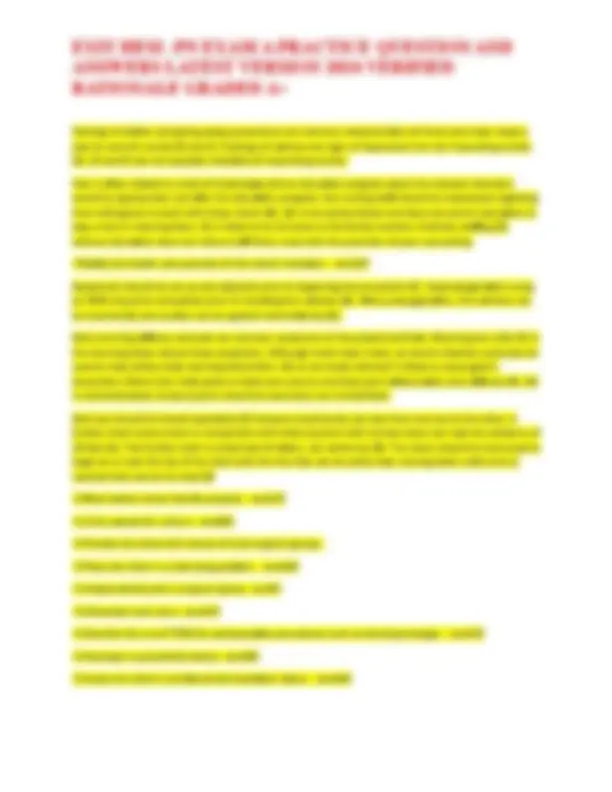
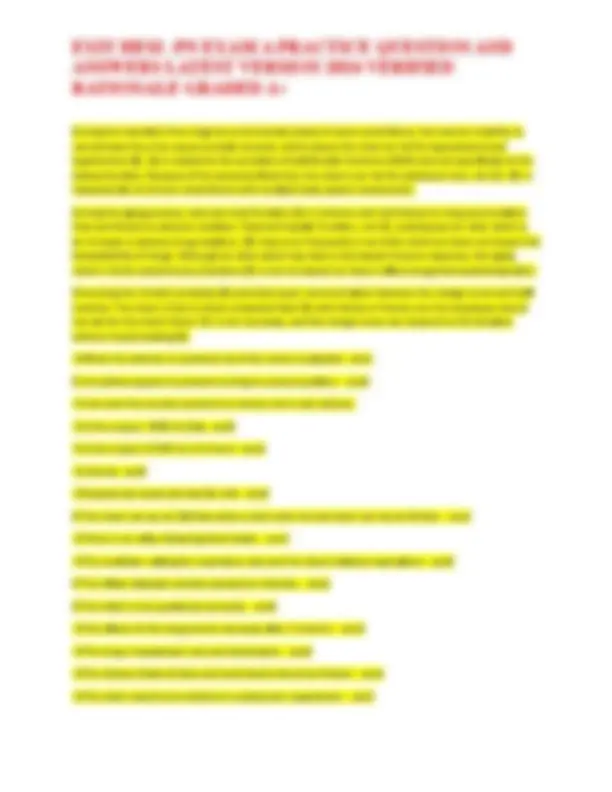
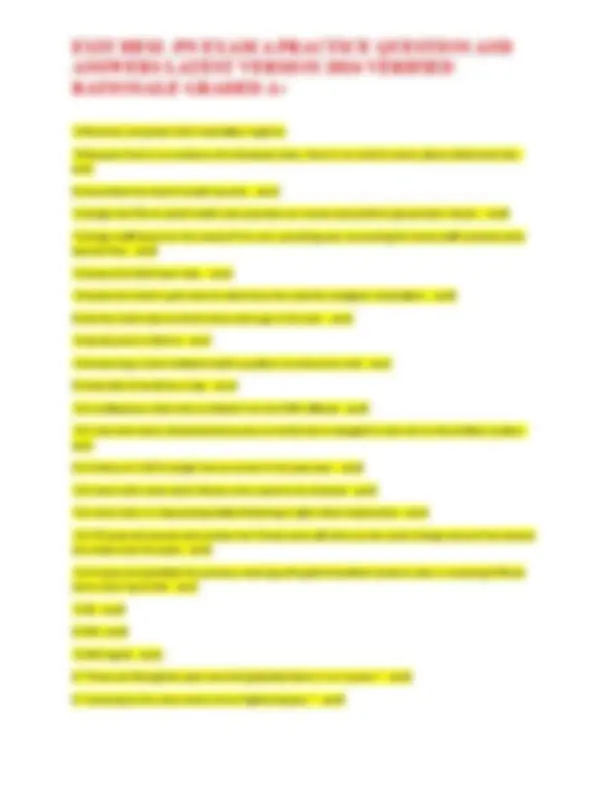
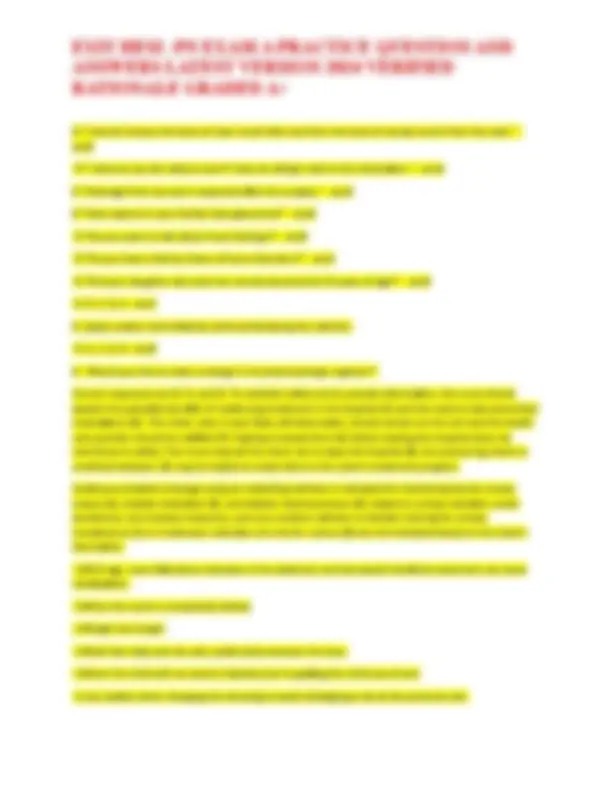
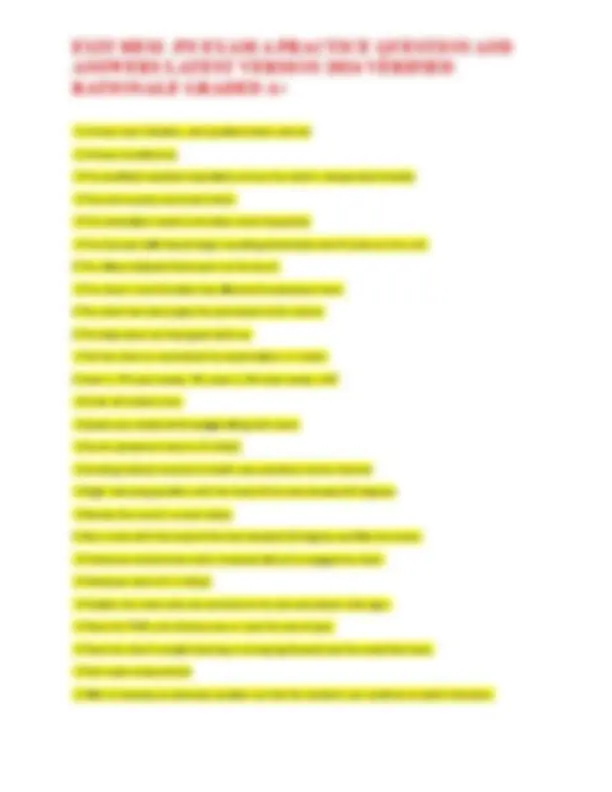
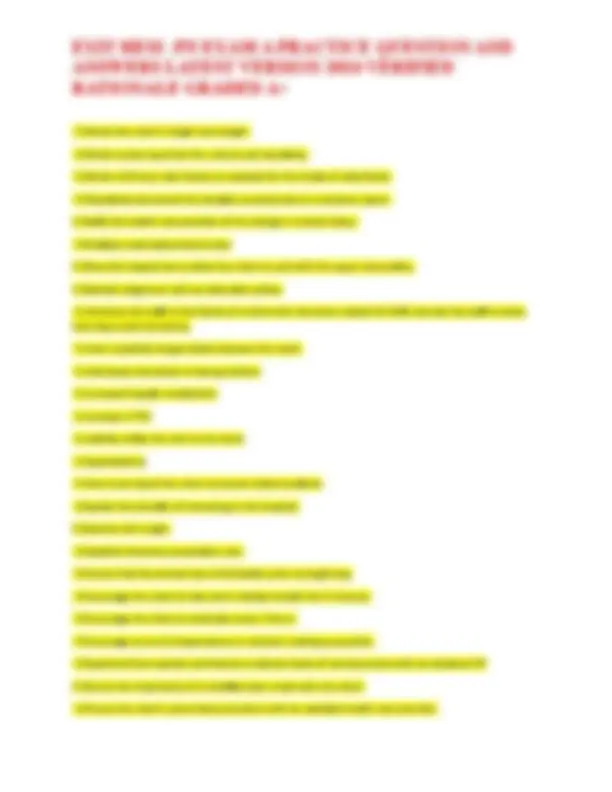
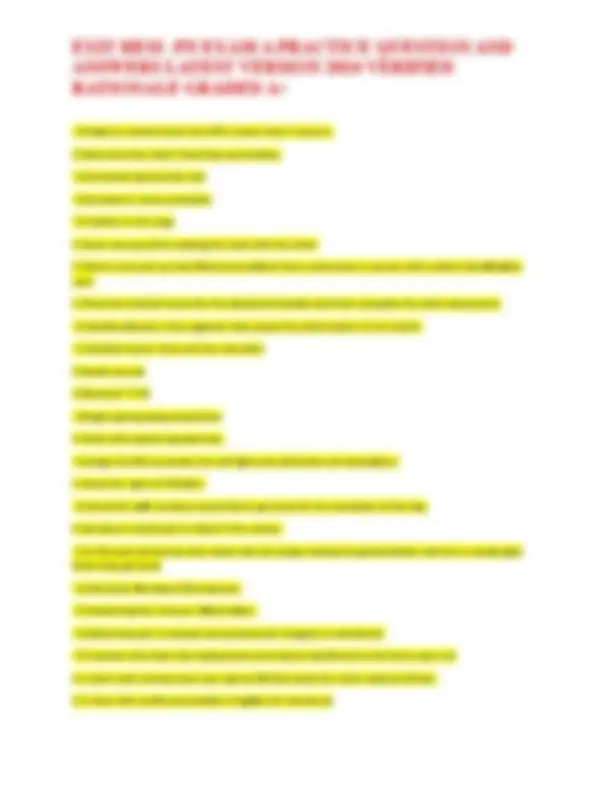
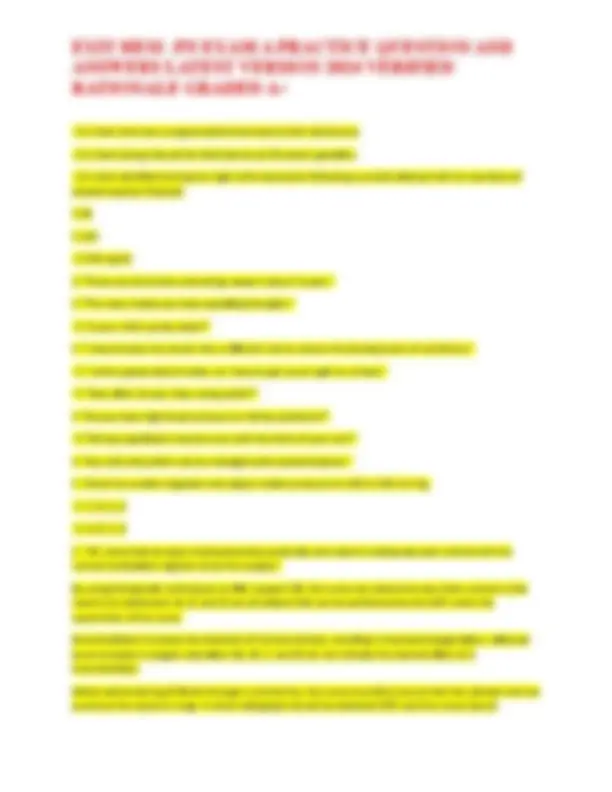
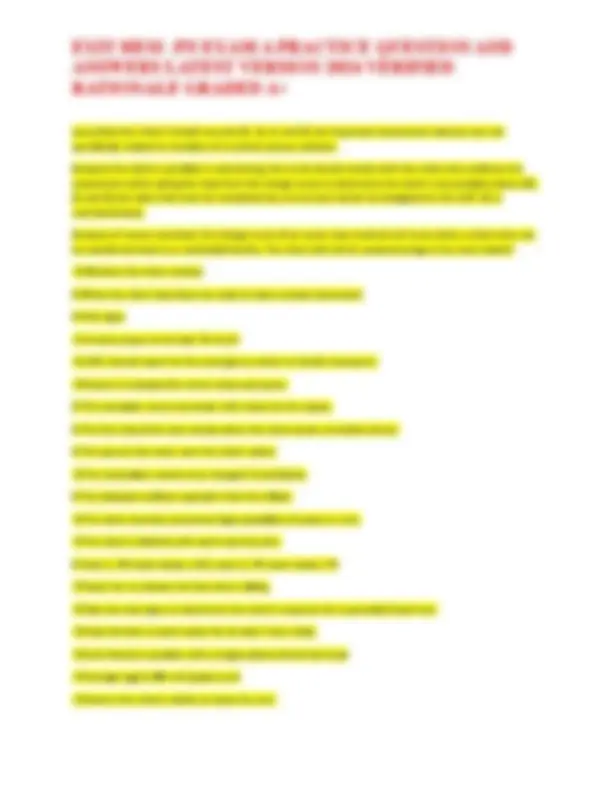
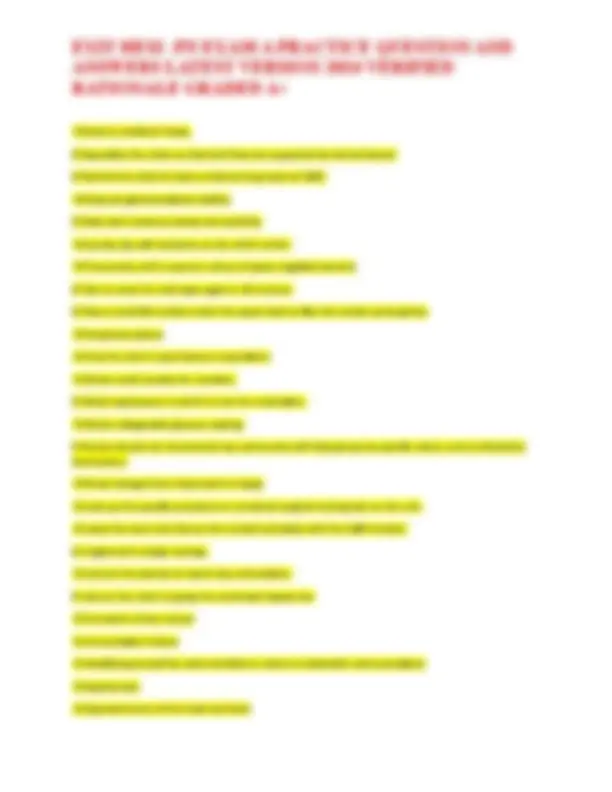
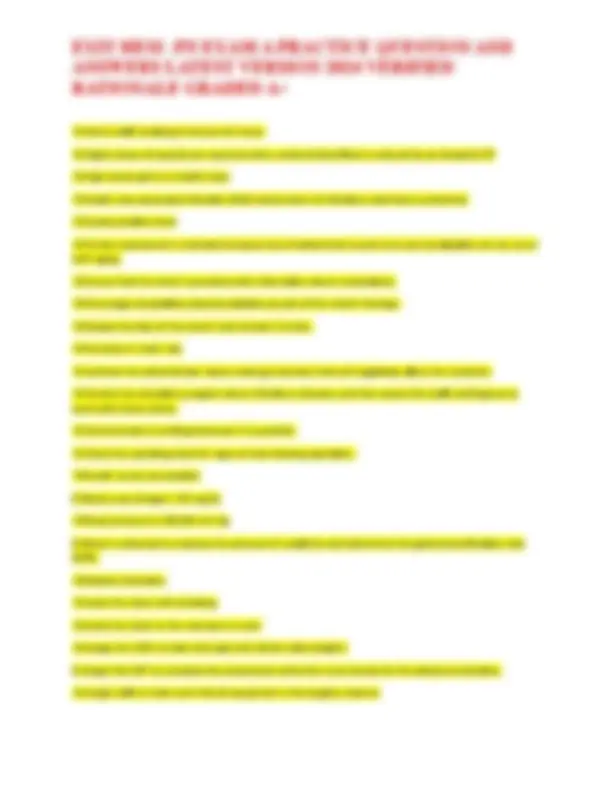
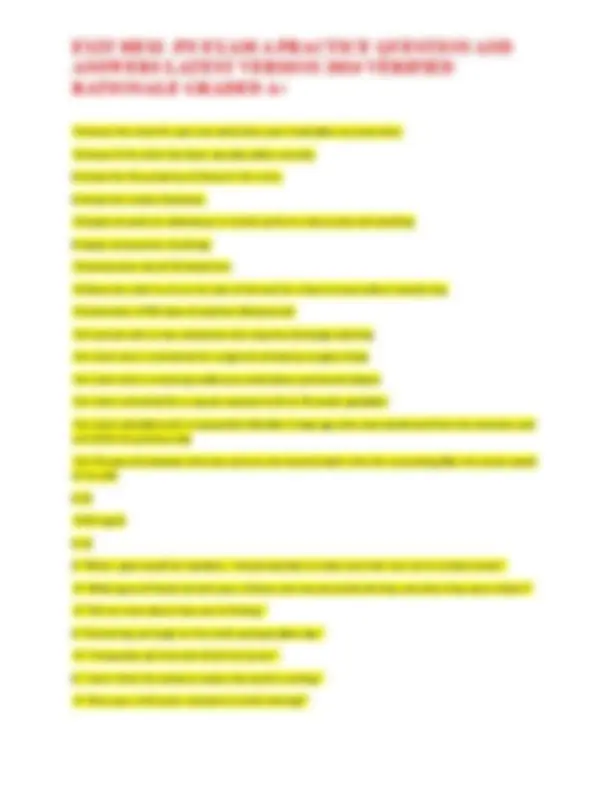
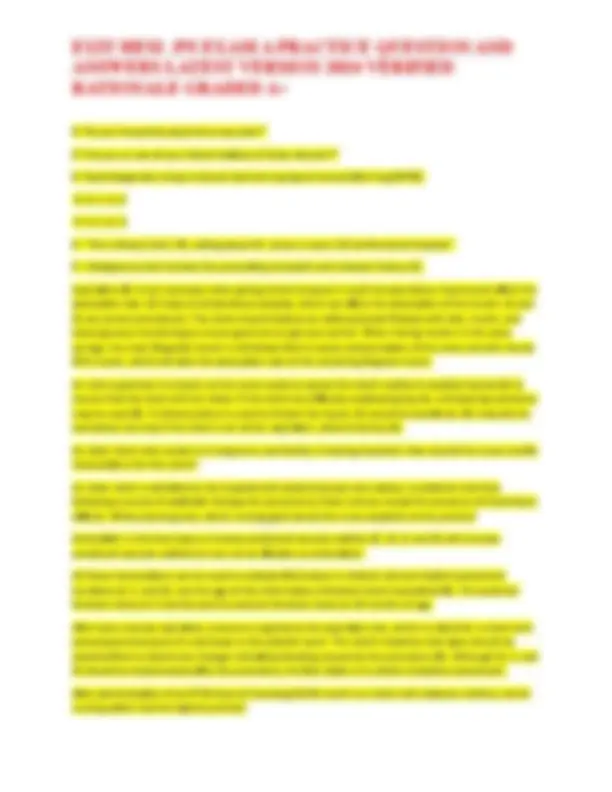
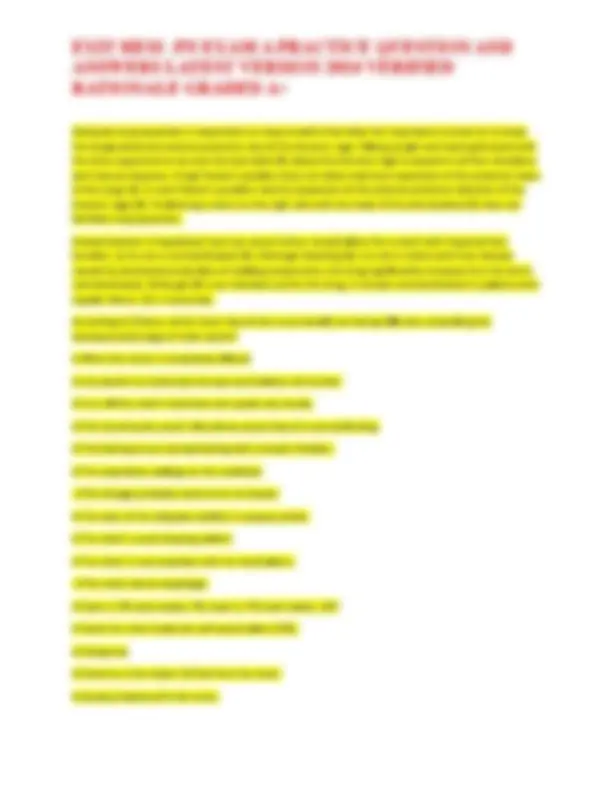
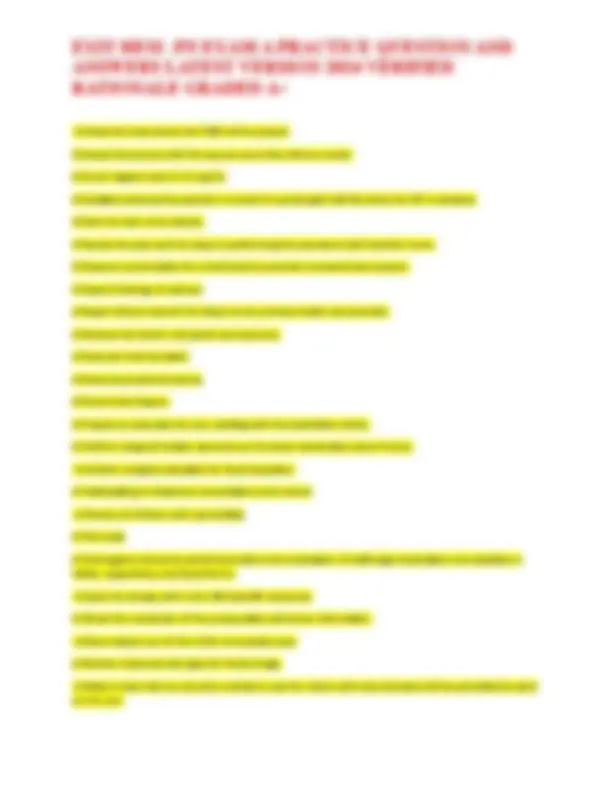
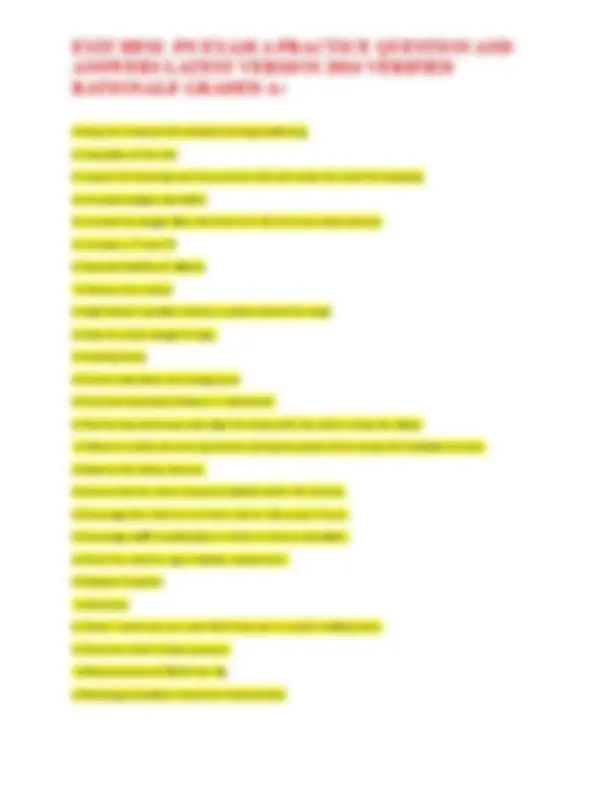
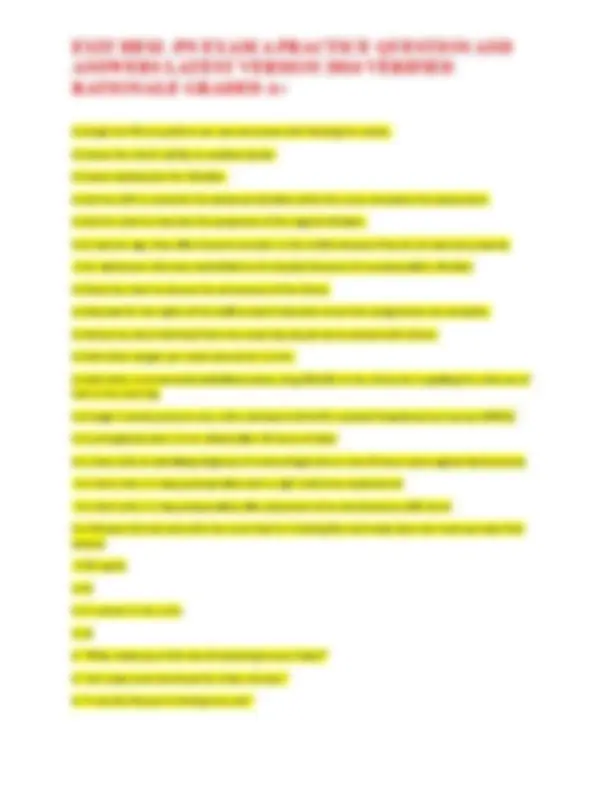
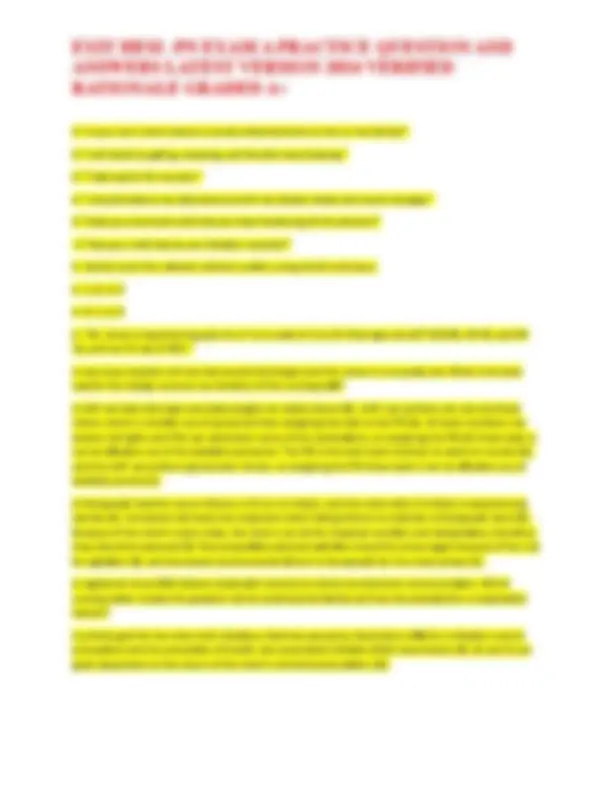
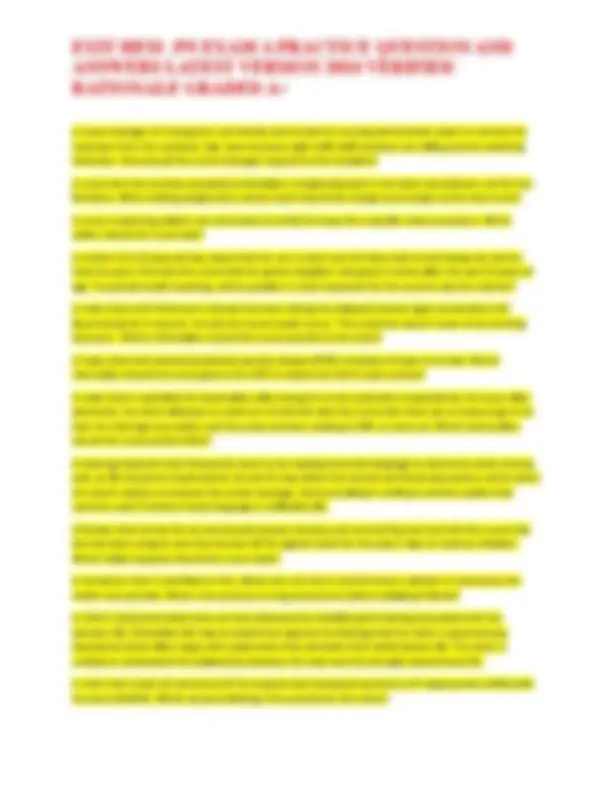
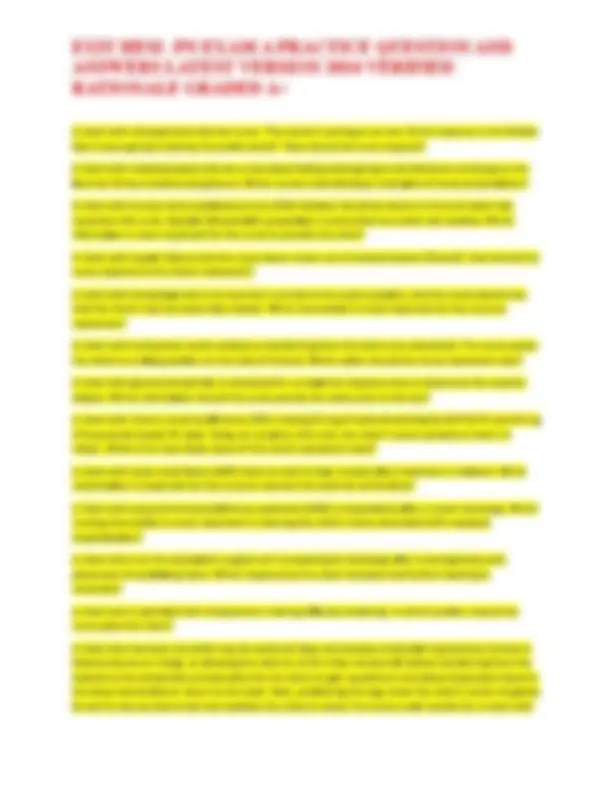
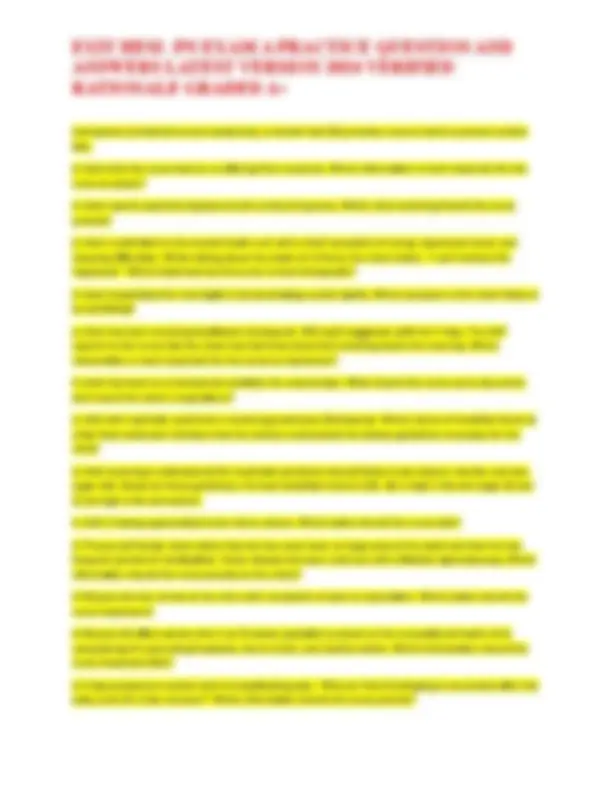
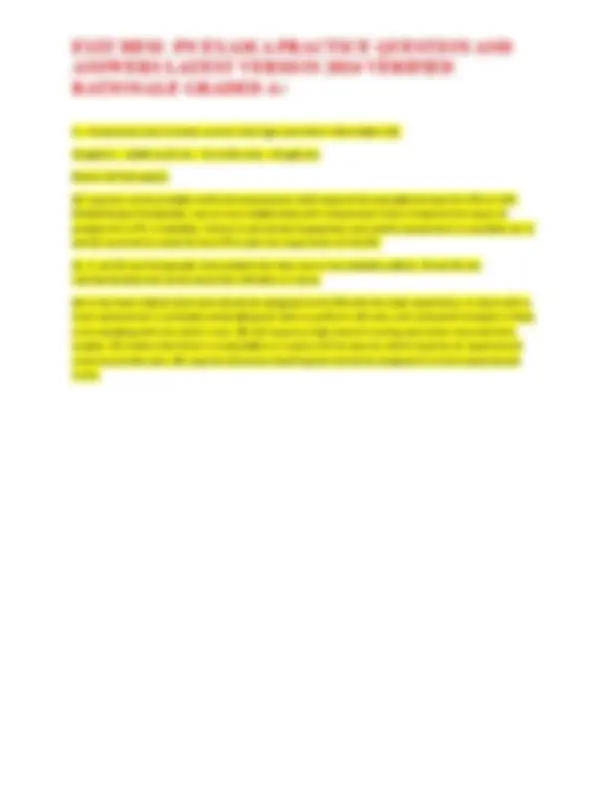
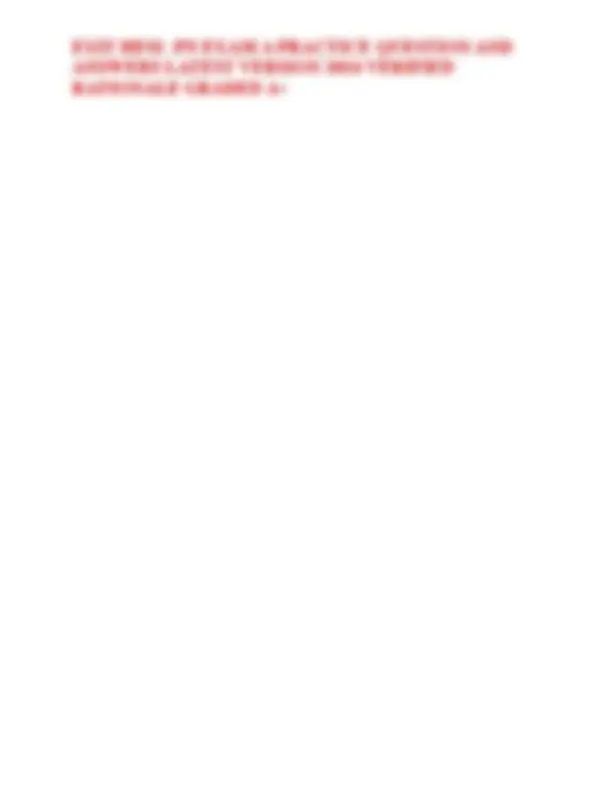
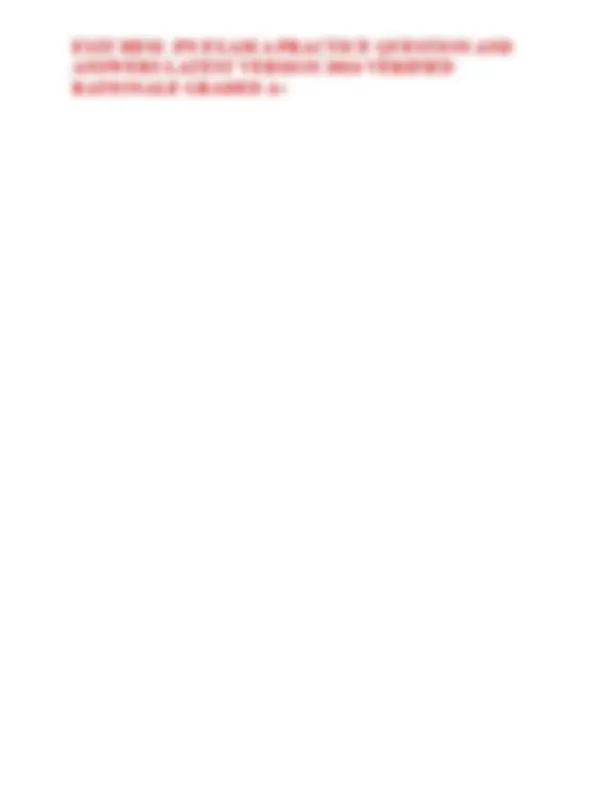
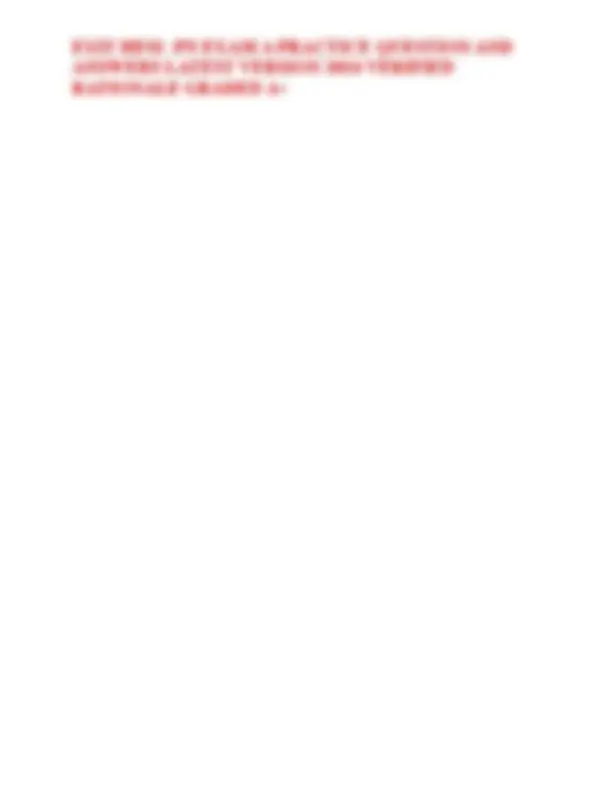
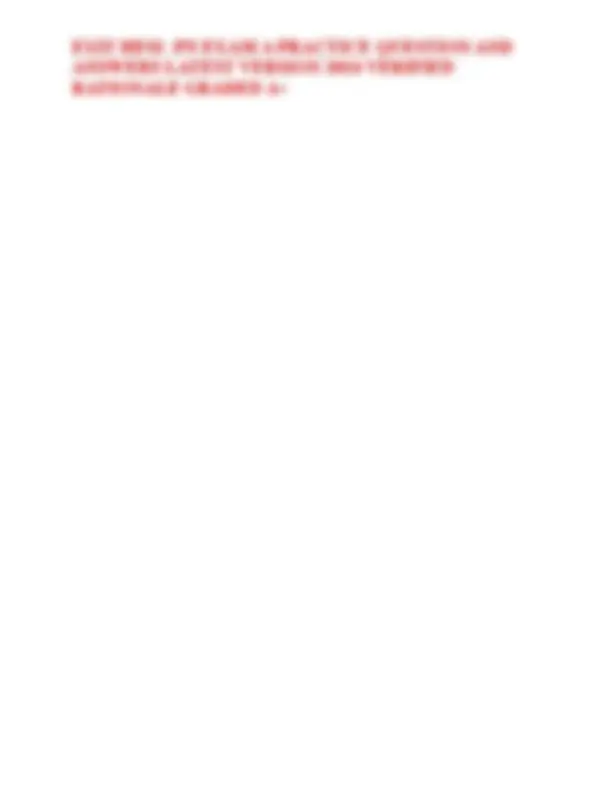
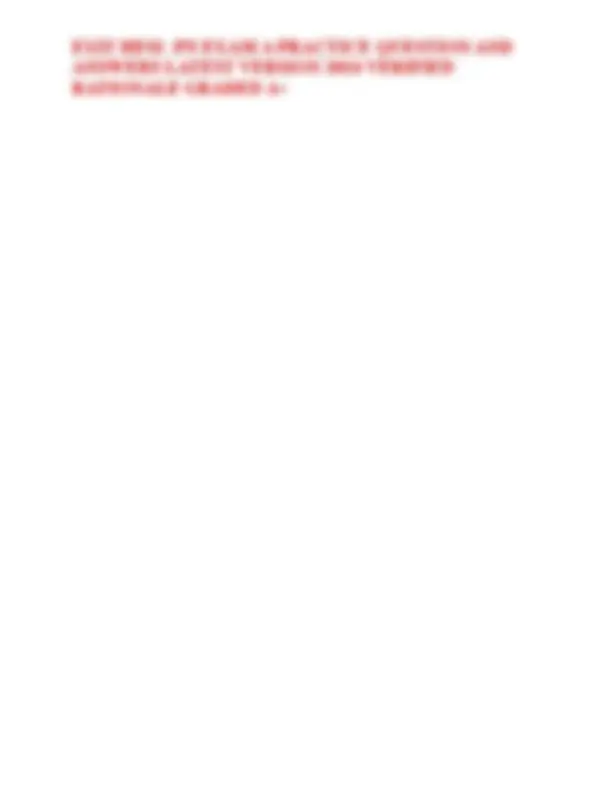
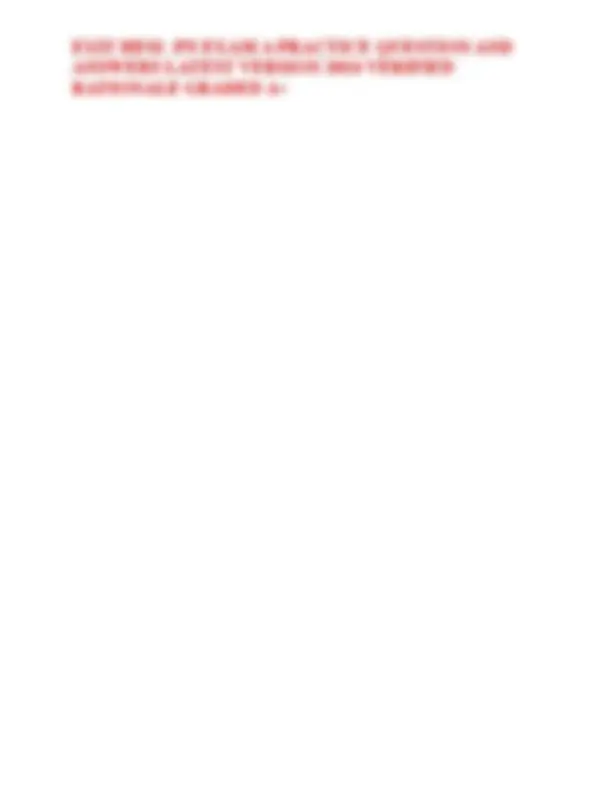
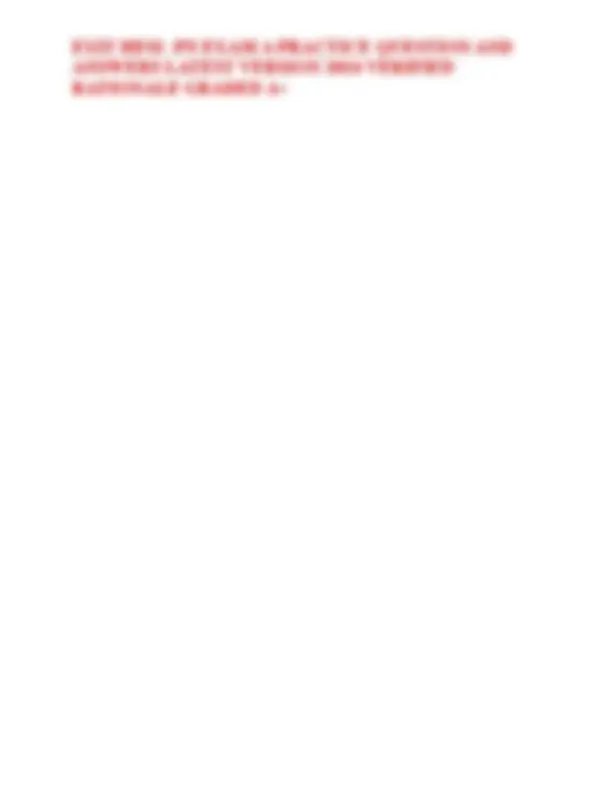
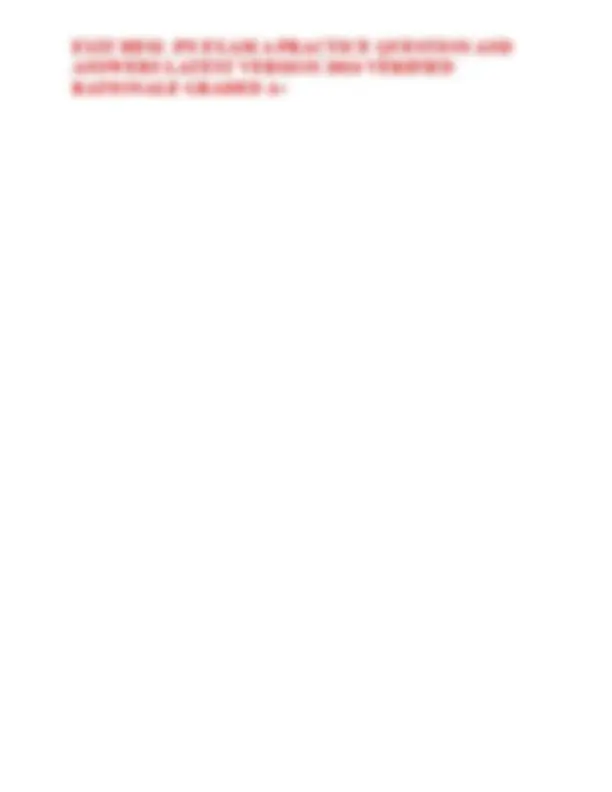


Study with the several resources on Docsity

Earn points by helping other students or get them with a premium plan


Prepare for your exams
Study with the several resources on Docsity

Earn points to download
Earn points by helping other students or get them with a premium plan
Community
Ask the community for help and clear up your study doubts
Discover the best universities in your country according to Docsity users
Free resources
Download our free guides on studying techniques, anxiety management strategies, and thesis advice from Docsity tutors
EXIT HESI -PN EXAM A PRACTICE QUESTION AND ANSWERS LATEST VERSION 20255 VERIFIED RATIONALE GRADED A+.pdf
Typology: Exams
1 / 45

This page cannot be seen from the preview
Don't miss anything!






































With aging, the abdominal muscles weaken as fatty tissue is deposited around the trunk and waist. Slowing peristalsis also affects the emptying of the colon, resulting in constipation (C). (A) is not the primary reason for the changes in body structure. (B) is not indicated because loss of muscle tone and constipation are age-related changes. (D) dismisses the client's concerns and does not help her understand the changes that she is experiencing. Which situation demonstrates proper application of client confidentiality requirements for the Health Insurance Portability and Accountability Act (HIPAA)? Which question is most relevant to ask the parents when obtaining the history of a 2-year-old child recently diagnosed with osteomyelitis? Which physiologic finding in an older adult contributes to an adverse drug reaction? Which pathophysiologic response supports the contraindication for opioids, such as morphine, in clients with increased intracranial pressure (ICP)? Which nursing intervention(s) should be implemented when caring for a client with bipolar disorder in the manic phase? (Select all that apply.) Which intervention(s) is(are) most helpful in evaluating the effectiveness of nursing and medical treatments for dehydration in a 36-month-old child? (Select all that apply.) Which instruction should the nurse provide to a client whose vision is being tested with a Snellen chart? Which client is best to assign to a graduate PN who is being oriented to a renal unit? Which assessment is most important for the nurse to implement when seeing a client with multiple myeloma? Which assessment finding indicates that nystatin (Mycostatin) swish and swallow, prescribed for a client with oral candidiasis, has been effective? Which assessment finding for a client with peritoneal dialysis requires immediate intervention by the nurse? When the nurse-manager posts a schedule for volunteers to be on call, one staff member immediately signs up for all available 7-to-3 day shifts. Other staff members complain to the charge nurse that they were not permitted the opportunity to be on call for the day shift. What action should the nurse- manager implement? When the mother's milk comes in, usually 2 to 3 days after delivery, women often report they feel a tingling sensation in their nipples (B) when let-down occurs. (A, C, and D) provide inaccurate information. When the administration at a large urban medical center decides to establish a unit to care for clients with infectious diseases, such as severe acute respiratory syndrome (SARS) and the avian flu, several
employees express fear related to caring for these clients. When choosing staff to work on this unit, which action is best for the nurse-manager to take? When faced with an impending disaster, hospital personnel may be alerted but should continue with current client care assignments until further instructions are received (D). Evacuation is typically a response of last resort that begins with clients who are most able to ambulate (A). (B) is premature and is likely to increase the chaos if incoming casualties are anticipated. (C) is poor utilization of personnel. When caring for a postpartum client, which intervention is best for the nurse to implement to promote increased peripheral vascular activity? When assisting a client who has undergone a right above-knee amputation with positioning in bed, which action should the nurse include? What instruction(s) related to foot care is(are) appropriate for the client with type 1 diabetes mellitus? (Select all that apply.) Use the following calculation (B): Until the census on the obstetrics (OB) unit increases, an unlicensed assistive personnel (UAP) who usually works in labor and delivery and the newborn nursery is assigned to work on the postoperative unit. Which client would be best for the charge nurse to assign to this UAP? Two days after swallowing 30 tablets of alprazolam (Xanax), a client with a history of depression is hemodynamically stable but wants to leave the hospital against medical advice. Which nursing action(s) is(are) most likely to maintain client safety? Trochanter rolls (D) should be placed on the lateral aspects of the thighs to prevent external rotation of the hips when the client is in a supine position. Although (A, B, and C) are supportive equipment used to maintain proper positioning of the client who is immobile, it is most important to maintain the lower extremities in the aligned anatomical position. A bed board (A) provides increased back support, especially with a soft mattress. The footboard (B) maintains the feet in dorsiflexion and prevents foot drop. The trapeze bar (C) allows the client to participate while turning in the bed, during transfers in and out of bed, or performing upper arm exercises. Transcutaneous electrical nerve stimulation (TENS) is prescribed for a client with chronic back pain. Which action(s) should the nurse take when preparing the client for this type of pain relief? (Select all that apply.) Thrombus formation, closed clamp, or crystallized medication can cause resistance while flushing a central line, so the line should be assessed for closed clamps (A) first. Irrigation with a larger syringe (B) will not alleviate the cause for the resistance and can rupture the line. A central line infection (C) should not cause resistance while flushing the line. The CVC should be flushed with normal saline (D) or a diluted solution of heparin (10-100 U/mL) after (A) is completed, if necessary.
span to assess an older client's adjustment to aging and plans teaching strategies to assist the clients attain integrity versus despair. (A, B, and C) are normal developmental tasks of older adults. The nurse-manager should speak privately with the nurse (A) to assess the nurse's motives and to discuss allowing other team members the opportunity to be on call for the day shift. (B) might become confrontational. (C) is irrelevant. (D) is not warranted. The nurse would be correct in withholding a dose of digoxin in a client with congestive heart failure without specific instruction from the health care provider if which finding was documented? The nurse should instruct the client to save the next urine sample (A) for observation of its appearance and for possible urinalysis. The client is reporting symptoms that may indicate the onset of a urinary tract infection. Increased fluid intake should be encouraged, unless contraindicated (B). (C) is only necessary if a calculus (stone) is suspected. (D) is not indicated by this client's symptoms. The nurse should encourage a laboring client to begin pushing at which point? The nurse should count the client's respirations, and document both the respiratory rate set by the ventilator and the client's independent respiratory rate (D). Never rely strictly on (A). Although the client's spontaneous breaths will be shallow and machine-assisted breaths will be deep, it is important to record machine-assisted breaths as well as the client's spontaneous breaths to get an overall respiratory picture of the client (B and C). The nurse recognizes which behavior(s) in a client as warning sign(s) of an impending suicide attempt? (Select all that apply.) The nurse plans to evaluate the effectiveness of a bronchodilator. Which assessment datum indicates that the desired effect of a bronchodilator has been achieved? The nurse performs tracheostomy suctioning on a comatose client. Place the interventions in order from first to last. The nurse performs an assessment on a client with heart failure. Which finding(s) is(are) consistent with the diagnosis of left-sided heart failure? (Select all that apply.) The nurse meets resistance while flushing a central venous catheter (CVC) at the subclavian site. Which action should the nurse perform? The nurse is teaching the parents of a 10-year-old child with rheumatoid arthritis measures to help reduce the pain associated with the disease. Which instruction should the nurse provide to these parents? The nurse is teaching a client newly diagnosed with diabetes mellitus about the subcutaneous administration of Regular and NPH insulin. Which statement indicates that the client needs further instruction?
The nurse is preparing to administer dalteparin (Fragmin) subcutaneously to an immobile client who has been receiving the medication for 5 days. Which finding indicates that the nurse should hold the prescribed dose? The nurse is preparing assignments for the day shift. Which client should be assigned to the staff RN rather than a PN? The nurse is preparing a client for surgical stabilization of a fractured lumbar vertebrae. Which indication(s) best supports the client's need for insertion of an indwelling urinary catheter? (Select all that apply.) The nurse is preparing a client for surgery scheduled in 2 hours. A UAP is helping the nurse. Which task is important for the nurse to perform, rather than the UAP? The nurse is planning a community teaching program regarding the use of folic acid to prevent neural tube birth defects. Which community group is likely to benefit most from this program? The nurse is obtaining a client's sexual history. Which finding requires additional follow-up regarding the client's self-image? The nurse is monitoring a client who is receiving bedside conscious sedation with midazolam hydrochloride (Versed). In assessing the client, the nurse determines that the client has slurred speech with diplopia. Based on this finding, what action should the nurse take? The nurse is developing a health risk assessment protocol for use in a well-baby clinic in a low-income neighborhood. Which information is most important for the nurse to include in the assessment? The nurse is correct in withholding an older adult client's dose of nifedipine (Procardia) if which assessment finding is obtained? The nurse is assisting a father to change the diaper of his 2-day-old infant. The father notices several bluish-black pigmented areas on the infant's buttocks and asks the nurse, "What did you do to my baby?" Which response is best for the nurse to provide? The nurse is assessing a client using the Snellen chart and determines that the client's visual acuity is the same as in a previous examination, which was recorded as 20/100. When the client asks the meaning of this, which information should the nurse provide? The nurse formulates a nursing diagnosis of pain related to muscle spasms for a client with extreme lower back pain associated with acute lumbosacral strain. Which is the best intervention for the nurse to implement? The nurse calls the primary health care provider to report the status of a postsurgical client. Place the statements in the correct SBAR communication format.
trauma. Objects should not be placed in the child's mouth (C) because it may pose a choking hazard. Although (D) should be implemented after the seizure, the nurse should not leave the child during a seizure to get help. The desired level III in conscious sedation includes slurred speech, glazed eyes, and marked diplopia. Because this is the desired outcome of the medication regimen, no action is needed but continuing to monitor the client (D). The airway is open if the client is able to talk (A). There are no signs of hypoglycemia (B). No reversal is necessary for the benzodiazepine (Versed) without signs of oversedation, such as respiratory depression (C). The correct choices are (A, C, and E). The TENS unit consists of a battery-operated transmitter, lead wires, and electrodes. The electrodes are placed directly over or near the site of pain (C), and hair or skin preparations should be removed before attaching the electrodes (A). The TENS unit is useful for managing postoperative pain or pain associated with postoperative procedures, such as removing drains or changing dressings (E). Electrodes are used, not needles (B) and, unlike with opioids, pain relief is achieved without drowsiness (D). The client with which fasting plasma glucose level needs the most immediate intervention by the nurse? The client with renal calculi (kidney stones) (D) is the most stable client for a PN who is being oriented. Straining urine and the administration of pain medication are tasks that can be safely performed with minimal risk of problems. (A, B, and C) require careful assessment from an experienced nurse because of the potential for significant complications. The client with colonized MRSA (A) is the most stable client, because colonization does not cause symptomatic disease. The gram-negative organisms causing pneumonia are typically resistant to drug therapy (B), which makes recovery very difficult. Positive blood cultures (C) indicate a systemic infection. Poor circulation places the diabetic with an infected ulcer (D) at high risk for poor healing and bone infection. The client will gain upper body strength and independence by using the overhead trapeze bar for positioning (B). Elevation of the residual limb is controversial (A) because a flexion contracture of the hip may result, so it is not necessary to maintain elevation during positioning. (C) is used for alignment following some hip surgeries. A prone position (D) should be encouraged to stretch the flexor muscles and prevent flexion contracture of the hip. The client who has arterial PVD may benefit from dependent positioning, and this can be achieved with bedside dangling (A), which will promote gravitation of blood to the feet, improve blood flow, and relieve pain. (B) is indicated for venous insufficiency (C) and indicated for bed rest. Ambulation (D) is indicated to facilitate collateral circulation and may improve long-term complaints of pain. The client should be taught to avoid aspirin (A) because the ingestion of aspirin or diuretics can precipitate an attack of gout. (B, C, and D) are all appropriate for the treatment of gout. The client's urinary pH can be increased by the intake of alkaline ash foods, such as citrus fruits and juices, which will
help reduce stone formation (B). Increasing fluids helps prevent urinary calculi (stone) formation and should be encouraged, even if the client must get up at night to urinate (C). Allopurinol has a rare but potentially fatal hypersensitivity syndrome, which is characterized by a rash and fever. The medication should be discontinued immediately if this occurs (D). The client has a normalized potassium level despite diuretic use (C). The kidney automatically secretes 90% of potassium consumed, but in chronic renal insufficiency (CRI), less potassium is excreted than normal. Therefore, the two potassium-wasting drugs, a thiazide diuretic and loop diuretic, are not likely to affect potassium levels. The normal potassium level is 3.5 to 5 mEq/L, and with a potassium level of 4 mEq/L, there is no reason to believe that the client is noncompliant with his treatment (A). Pears and nuts do not affect the serum potassium level (B). There is no need for a potassium supplement (D) because the client's potassium level is within the normal range. The charge nurse working in the surgical department is making shift assignments. The shift personnel include an RN with 12 years of nursing experience, an RN with 2 years of nursing experience, and an RN with 3 months of nursing experience. Which client should the charge nurse assign to the RN with 3 months of experience? The charge nurse will be responsible for providing a report to the home care unit if the transfer occurs (A). The client is infected and an employee who works on an OB unit should be assigned to clean cases in case the employee is required to return to the OB unit (B). This requires the skills of a registered nurse (RN) to do discharge teaching and provide emotional support (D). This may require skills beyond the level of this UAP. The charge nurse overhears a staff member asking for a doughnut from a client's meal tray. Which action should the charge nurse implement? The charge nurse of a medical surgical unit is alerted to an impending disaster requiring implementation of the hospital's disaster plan. Specific facts about the nature of this disaster are not yet known. Which instruction should the charge nurse give to the other staff members at this time? The charge nurse of a 16-bed medical unit is making 0700 to 1900 shift assignments. The team consists of two RNs, two PNs, and two UAP. Which assignment is the most effective use of the available team members? The Centers for Disease Control and Prevention indicate that vaccines are among the most widely used, effective, and safe medical products in use today. Assessing the infant immunization histories in clients from disadvantaged socioeconomic groups (B) is the most effective method for determining these infants' susceptibilities to vaccine-preventable diseases. Assessment of (A, C, and D) provides valuable information but does not supply information about infants' susceptibilities to vaccine-preventable diseases, which are major causes of infant mortality and morbidity. The blood pressure (A) should be assessed first. Preeclampsia is a multisystem disorder, and women older than 35 years and have chronic hypertension are at increased risk. Classic signs include headache,
credentials in telehealth communication (B), one is taking responsibility for the encounter. E-mail initiated by the client (D) poses less risk than sending records via the Internet. SBAR: S = Situation and includes introduction of the nurse and client/setting (B). Rhabdomyolysis is characterized by destruction of muscles that release myoglobin, causing myoglobinuria, which places the client at risk for acute renal failure, so an increased blood urea nitrogen (BUN) level (B) indicates a decrease in renal function. Blood in the urine from the accompanying breakdown of red blood cells contributes to proteinuria (A), an expected finding. Metabolic acidosis is the potential complication, not alkalosis (C). During the diuretic phase of acute renal failure, there can be a normal output volume (D) (approximately 2000 mL/day), which can result from IV fluid hydration. Resting in bed with the head of the bed elevated 20 degrees and flexing the knees reduces stress on the lower back muscles (C). Range-of-motion exercises can result in paravertebral muscle spasms and increased pain (A). Bending the knees, rather than (B), reduces stress on the lower back. (D) places stress on the lower back and increases the client's pain. R = Recommendations and includes an explanation of why you are calling or a suggestion about which action should be taken (D). Pushing begins with the second stage of labor, when the cervix is completely dilated at 10 cm (C). If pushing begins before the cervix is completely dilated (A, B, and D), the cervix can become edematous and may never dilate completely, necessitating an operative delivery. The most effective pushing occurs when the cervix is completely dilated and the woman feels the urge to push (Ferguson's reflex). Prior to administering an oral suspension, which intervention is most important for the nurse to implement? Past medical records must be "secured" and "reasonably protected" from inadvertent viewing (D). A locked room or file cabinet can serve this purpose, and when any protected health information (PHI) is discarded, it must be shredded. A person's name only (without their diagnosis or treatment) is not considered confidential or PHI (A). Nurses may suggest categories of community resources, with examples, such as Alcoholics Anonymous (B), but cannot market a specific program in which they have a financial interest. Others can pick up a client's filled prescriptions (C). Osteomyelitis can be caused by internal infections, such as otitis media (A). (B and C) are normal developmental findings for a 2-year-old. Osteomyelitis is caused by a bacterial infection, so (D) is not relevant. Orchitis is an acute testicular inflammation resulting from recurrent urinary tract infection, recurrent sexually transmitted disease (STD), or an indwelling urethral urinary catheter causing pain on ejaculation, scrotal pain, blood in the semen, and penile discharge, so the nurse should determine the presence of other symptoms (C). Although all men should practice TSE, the client's symptoms are suggestive of an
inflammatory syndrome rather than testicular cancer (A). Although hematuria (B) is associated with renal disease or calculi (D), the client's pain is associated with ejaculate, not urine. Opaque or cloudy dialysate outflow is an early sign of peritonitis. The nurse should obtain a specimen for culture, assess the client, and notify the health care provider (A). (B and C) are desired. (D) is commonly done to prevent hypokalemia. Online educational programs are available around the clock, so staff can engage in continuing education programs when the opportunity arises, such as during periods of low census (A). (B) is not the responsibility of the nursing staff. (C) is not the best use of staff and does not use the extra time provided by the low census. The charge nurse should use the time to improve the unit, and requesting additional assignments is not necessary (D) One of the earliest signs of increased intracranial pressure (ICP) is a change in mental status (C). It is important to act early and quickly when symptoms of increased ICP occur. Because his oxygen saturation is normal, the administration of oxygen (A) is not the top priority. Vital signs should be monitored frequently (B), but the client's confusion should be reported immediately. (D) is not a useful intervention. Nuchal rigidity (neck stiffness) is a characteristic of meningeal irritation and is elicited by attempting to flex the neck and place the chin to the chest (C). Although (A, B, and D) may occur in meningitis, (A) describes exaggerated spinal nerve reflex responses, (B) describes opisthotonus, and (D) may be related to cranial nerve pathology of the trigeminal nerve. Nifedipine (Procardia) is a calcium channel blocker that causes a decrease in blood pressure. It should be withheld if the blood pressure is lowered, and 90/56 mm Hg is a low blood pressure for an adult male (A). A pulse rate less than 60 beats/min is an indication to withhold the drug (B). A potassium level of 3. mEq/L is low (normal, 3.5 to 5.0 mEq/L), but this finding does not affect the administration of Procardia (C). Urine output of more than 30 mL/hr, or 120 mL in 4 hours, is normal. Although a 200- mL output in 4 hours is slightly less than normal and warrants follow-up, it is not an indication to withhold a nifedipine (Procardia) dose (D). Mycostatin swish and swallow is prescribed for its local effect on the oral mucosa, reducing the white curdlike lesions in the mouth and larynx (C). The ability to swallow (A) does not indicate that the medication has been effective. (B and D) do not reflect effectiveness of the local medication. Multiple myeloma is a tumor that causes bone marrow changes, which most commonly manifest as pain, so measurement of the client's pain is the highest priority (C). (A, B, and D) are part of the complete assessment but do not have the priority of (C) for this client. Mongolian spots (D) are areas of bluish-black or gray-blue pigmentation seen primarily on the dorsal area and buttocks of infants of Asian or African decent or dark-skinned babies. (A) is a defensive answer. Although Mongolian spots occur more frequently in those of Asian and African decent, (B) does not
but the isolation and dependence associated with hospitalization alter the client's sense of control and affect the client's cognitive ability to understand (B) and participate (D) in the hospitalized plan of care. HIV infection causes depression of cell-mediated immunity that allows an overgrowth of Candida albicans (oral moniliasis), which appears as white, cheesy plaque or lesions that resemble milk curds. To ensure effective contact of the medication with the oral lesions, oral liquids should be consumed and oral hygiene performed before swishing the liquid Mycostatin (A). (B and C) provide the client with additional information about the pathogenesis and treatment of opportunistic infections, but (A) allows the client to participate in self-care of the oral infection. Dietary restriction of spicy foods reduces discomfort associated with stomatitis, but restriction of dairy products is not indicated (D). Glomerulonephritis damages the renal glomeruli and affects the kidney's ability to clear serum creatinine into the urine. Creatinine clearance is a 24-hour urine specimen test, so all urine should be collected during the period of the study or the results are inaccurate (A). As renal function decreases, the creatinine level will decrease in the urine (B). Dialysis is usually started when the GFR is 12 mL/min (C). There is no need to record the frequency and amount of each voiding (D) during the time span of urine collection. Glaucoma has a definite genetic link, so clients should be screened for a positive family history, especially an immediate family member (D). (A and C) are not related to glaucoma. Glaucoma rarely causes pain (B), which is why screening is so important. Girls are expected to mature sexually and grow physically sooner than boys. Furthermore, girls only grow an average of 2 inches after menses begins (D). (A) is not appropriate at this time. The mother is worried that something is wrong with her son physically. (B) has less to do with stature than growth and development. (C) is not related to growth hormone deficiencies, which are idiopathic (without known causes). Fragmin is an anticoagulant used to prevent deep vein thrombosis (DVT) in the at-risk client. If the client develops overt signs of bleeding, such as guaiac-positive stool (B) while receiving an anticoagulant, the medication should be held and coagulation studies completed. (A) is not an indication to hold the medication unless accompanied by signs of bleeding. (C) is an expected result. (D) is related to fluid volume, rather than anticoagulant therapy. Folic acid is needed early in pregnancy to prevent neural tube defects; the group most likely to be considering pregnancy is (C). Parents with children who already have a neural tube defect such as spina bifida (A) are not as invested in the content as (C). High school age students (B) may have interest in the topic but as a group are less likely to anticipate the likelihood that problems could occur in their lives than (C). (D) may be interested if planning future pregnancies, but have higher learning priorities during the postpartum period. Flow rate = 15 gtt/mL × (1000 mL/8 hr) × (1 hr/60 min) = 32 gtt/min
Feelings of elation and giving away possessions are common characteristics of those who have made a plan to commit suicide (B and C). Feelings of sadness are signs of depression but not impending suicide (A). (D and E) are not typically indicative of impending suicide. Fear is often related to a lack of knowledge and an education program about the relevant disorders would be appropriate, but after the education program, the nursing staff should be reassessed regarding their willingness to work with these clients (B). (A) is too authoritarian and does not permit education to play a role in reducing fears. (C) is likely to be intrusive to the family member. Arbitrary staffing (D) without education does not reduce staff fears, even with the provision of peer counseling. F.Notify the health care provider of the client's intention. - ansCDF Equipment should be set up and adjusted prior to beginning the procedure (C). Hyperoxygenation using an MRB should be completed prior to inserting the catheter (B). After preoxygenation, the catheter can be inserted (A) and suction can be applied intermittently (D). Early morning stiffness and pain are common symptoms of rheumatoid arthritis. Warming the child (C) in the morning helps reduce these symptoms. Although moist heat is best, an electric blanket could also be used to help relieve early morning discomfort. (A) on an empty stomach is likely to cause gastric discomfort. Warm (not cold) packs or baths are used to minimize joint inflammation and stiffness (B). (D) is contraindicated, because joints should be exercised, not immobilized. Each eye should be tested separately (C) because visual acuity can vary from one eye to the other. A Snellen chart scores vision in comparison with what a person with normal vision can read at a distance of 20 feet (A). The Snellen chart is comprised of letters, not sentences (B). The client should be instructed to begin at or near the top of the chart with the line that can be easily read, moving down until a line is reached that cannot be read (D) E.Wear leather shoes that fit properly. - ansACE E.Urine sample for culture - ansABD E.Provide the client with names of local support groups. E.Place the client in a side-lying position. - ansABD E.Independently joins a support group - ansBC E.Distended neck veins - ansACD E.Describe the use of TENS for postoperative procedures such as dressing changes. - ansACE E.Decrease in periorbital edema - ansABE E.Assess the client's nutritional and hydration status. - ansADE
D.The amount of caffeine that the client consumes during the day - ansA D.Team 1, PN team leader, UAP; team 2, RN team leader, PN - ansA D.Teach the preoperative client coughing and deep breathing exercises. - ansC D.Teach the client how to perform leg exercises while in bed. - ansC D.Sitting upright and forward with both arms supported on an over the bed table - ansD D.Serum sodium level of 137 mEq/L - ansD D.Remind the administrator that watching television helps the night shift staff remain awake. - ansC D.Reduce physical activity. - ansA D.Prepare to administer sodium bicarbonate IV over 30 minutes. - ansB D.Postpartum women attending a baby care class - ansC D.Position in reverse Trendelenburg with the feet firmly against the foot of the bed. - ansC D.Place trochanter rolls on the lateral aspects of the client's thighs. - ansD D.Place in the recovery position before going for help. - ansA D.Opioids suppress respirations, which increases Pco2 and contributes to an elevated ICP. - ansD D.Old medical records are kept in a locked file cabinet in the department. - ansD D.Offer the client emotional support. - ansD D.Observe mucous membranes. - ansACD D.Notify the supervisor that the staff needs additional assignments. - ansA D.Normal bowel patterns are reestablished. - ansB D.Nominate the nurse for employee of the month. - ansA D.Monitor fetal heart rate for 1 hour after the procedure. D.Mobility limitations - ansC D.Maintain consistent salt levels in the diet when client is taking lithium. D.Level of consciousness - ansC D.Lateral facial paralysis - ansC D.Intraoperative bladder decompression
D.Instruct the UAP to obtain incontinent pads for the client. - ansC D.Instruct the client to take medications as prescribed. D.Inquire about a history of kidney stones. - ansC D.Inform the client that the scheduled Pap test cannot be done today. - ansD D.Increased risk of autoimmune disorders - ansA D.Include the client in planning the course of treatment. - ansC D.Immobilize swollen joints during acute exacerbations until function returns. - ansC D.Head circumference - ansB D.Grasp the transfer belt at the client's sides to provide movement of the client. - ansB D.Flush the line with heparin. - ansA D.Face the client and speak in a normal tone of voice. - ansD D.Explain to the client that drowsiness may occur immediately after using TENS. D.Explain that the client's capillary glucose will be checked at 1130. - ansA D.Evaluate pain management plan. - ansB D.Dyspnea D.Discard the first voiding, and record the time and amount of urine of each voiding for 24 hours. - ansA D.Dependent pitting edema - ansB D.Decreased blood pressure - ansA D.Decrease in urine output D.Culture of a diabetic foot ulcer shows gram-positive cocci - ansA D.Continue with current assignments until more instructions are received. - ansD D.Continue to monitor the client. - ansD D.Consult the agency's policies and procedures manual and follow the guidelines. - ansD D.Call the nurse-manager to the client's room immediately. - ansB D.Call for the charge nurse to check the advanced directive while continuing to assess the client. - ansD D.Begin by identifying the first line that is hard to read. - ansC
D."I should remove the dose of clear insulin first and then the dose of cloudy insulin from the vials." - ansB D."I observe my skin daily to see if I have an allergic rash to the medication." - ansA D."Drainage from my ears is expected after the surgery." - ansB D."Does anyone in your family have glaucoma?" - ansD D."Do you want to talk about these feelings?" - ansB D."Do you have a family history of bone disorders?" - ansA D."Did your daughter also start her menstrual period at 12 years of age?" - ansD D. D, C, B, A - ansC D. Apply suction intermittently while withdrawing the catheter. D. A, C, D, B - ansB D. "Would you like to make a change in his pharmacologic regimen?" Correct responses are (C, D, and F). To maintain safety and to provide information, the nurse should explain the potential benefits of continuing treatment in the hospital (C) and the need to take prescribed medications (D). This client, who is very likely self-destructive, should remain on the unit and the health care provider should be notified (F). Signing a release form (A) before leaving the hospital does not contribute to safety. The nurse may ask the client not to leave the hospital (B), but pressuring clients is unethical behavior. (E) may be helpful at a later time in this client's treatment program. Continuous bladder drainage using an indwelling catheter is indicated for monitoring hourly urinary output (A), bladder distention (B), and bladder decompression (D) related to urinary retention under anesthesia. Less invasive measures, such as a condom catheter or bladder training for urinary incontinence (C) or midstream collection of urine for culture (E) are not indicated based on the client's description. C.With age, more fatty tissue develops in the abdomen and decreased intestinal movement can cause constipation. C.When the cervix is completely dilated C.Weight and length C.Wash feet daily and dry well, particularly between the toes. C.Warm the child with an electric blanket prior to getting the child out of bed. C.Use caution when changing the dressing to avoid dislodging a clot at the puncture site.
C.Urinary tract infection, with positive blood cultures C.Urinary incontinence C.The ventilator-assisted respirations minus the client's independent breaths C.The oral mucosa is pink and intact. C.The medication needs to be taken more frequently. C.The licensed staff should begin counting wheelchairs and IV poles on the unit. C.The inflow dialysate feels warm to the touch. C.The client's renal function has affected his potassium level. C.The client has had surgery for permanent birth control. C.The baby does not have good latch-on. C.Tell the client to reschedule the examination in 1 week. C.Team 1, PN team leader, PN; team 2, RN team leader, UAP C.Strain all voided urine. C.Speak very slowly while exaggerating each word. C.Serum potassium level is 2.5 mEq/L C.Sending medical records to health care providers via the Internet C.Right side-lying position with the head of the bed elevated 45 degrees C.Review the nurse's current salary. C.Rest in bed with the head of the bed elevated 20 degrees and flex the knees. C.Provide an environment with increased stimuli to engage the client. C.Potassium level of 3.3 mEq/L C.Position the client who has vomited on his side and obtain vital signs. C.Place the TENS unit directly over or near the site of pain. C.Place the client's weight-bearing or strong leg forward and the weak foot back. C.Pain scale measurement C.Offer to develop an alternate solution so that the residents can continue to watch television.